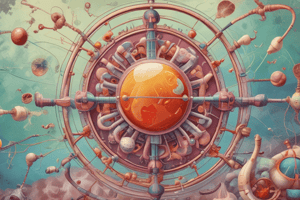Podcast
Questions and Answers
What is the primary target of quinolone antimalarial drugs?
What is the primary target of quinolone antimalarial drugs?
- Mitochondria
- Food vacuole (correct)
- Nucleus
- Cell membrane
Which enzyme do antifolates inhibit in the parasite?
Which enzyme do antifolates inhibit in the parasite?
- Dihydrofolate reductase (correct)
- DNA Polymerase
- Helicase
- RNA Polymerase
What side effect is commonly associated with mefloquine?
What side effect is commonly associated with mefloquine?
- Memory loss
- Vision problems
- Neurological symptoms (correct)
- Fevers
What contributes to the emergence of drug-resistant strains of Plasmodium parasites?
What contributes to the emergence of drug-resistant strains of Plasmodium parasites?
To combat drug-resistant strains, what strategy is recommended?
To combat drug-resistant strains, what strategy is recommended?
What is the mechanism of action of Quinolone antimalarial drugs?
What is the mechanism of action of Quinolone antimalarial drugs?
Which class of antimalarial drugs inhibits dihydrofolate reductase?
Which class of antimalarial drugs inhibits dihydrofolate reductase?
What is the main source of Artemisinin derivatives, such as artemether?
What is the main source of Artemisinin derivatives, such as artemether?
Which antimalarial drug class acts rapidly and kills Plasmodium parasites throughout the asexual blood stages?
Which antimalarial drug class acts rapidly and kills Plasmodium parasites throughout the asexual blood stages?
Why is the development of new antimalarial drugs and the use of combination therapies essential?
Why is the development of new antimalarial drugs and the use of combination therapies essential?
Flashcards are hidden until you start studying
Study Notes
Antimalarial Drugs
Antimalarial drugs are a crucial part of the global effort to combat malaria, a disease that affects millions of people worldwide. The emergence of drug-resistant strains of the parasite has made the development of new antimalarial drugs and the use of combination therapies essential. In this article, we will discuss the different types of antimalarial drugs, their mechanisms of action, side effects, and resistance.
Types of Antimalarial Drugs
Antimalarial drugs can be classified into three main groups based on their mechanism of action:
-
Quinolone drugs: Chloroquine and hydroxychloroquine are the most well-known examples of this class. They target the food vacuole of the parasite, interfering with the detoxification of hematin, a toxic byproduct of hemoglobin degradation.
-
Antifolates: These drugs act on the folate pathway by inhibiting dihydrofolate reductase, thereby preventing the parasite from synthesizing DNA. Examples include pyrimethamine, proguanil, and sulfonamides.
-
Artemisinin derivatives: Derived from the Chinese sweet wormwood plant, Artemisia annua, these drugs inhibit the sarco/endoplasmic reticulum calcium ATPase found in Plasmodium parasites. They are potent antimalarials, acting rapidly and killing Plasmodium parasites throughout the asexual blood stages. Examples include artemether, lumefantrine, mefloquine, and artesunate.
Mechanism of Action
The mechanism of action of antimalarial drugs involves interfering with key processes in the life cycle of the parasite. For example, quinolone drugs target the food vacuole, preventing the parasite from detoxifying hematin. Antifolates inhibit dihydrofolate reductase, blocking the synthesis of DNA. Artemisinin derivatives inhibit the sarco/endoplasmic reticulum calcium ATPase, disrupting the parasite's energy production and causing rapid parasite death.
Side Effects
Each antimalarial drug has its own set of side effects. For example, chloroquine can cause nausea, vomiting, and headaches. Mefloquine can cause neurological symptoms, such as dizziness, headaches, and hallucinations. Artesunate can cause severe muscle pain and cramps. Side effects can vary depending on the individual's health condition and the drug's dose. It is essential to consult a healthcare provider for proper guidance on managing side effects.
Resistance
The emergence of drug-resistant strains of Plasmodium parasites is a significant challenge in the fight against malaria. Resistance arises due to genetic mutations or gene amplifications that allow the parasite to survive and multiply despite drug exposure. Some factors that facilitate the emergence of resistance include the parasite mutation rate, overall parasite load, strength of drug selected, treatment compliance, and adherence to malaria treatment guidelines. Improper dosing, poor pharmacokinetic properties, and the use of fake drugs can also contribute to resistance.
To combat drug-resistant strains, it is crucial to use combination therapies that target different mechanisms within the parasite, reducing the risk of multidrug-resistant parasites. Continuous assessment of molecular markers and therapeutic efficacy studies in malaria-endemic regions can help detect the spread of resistance and guide changes in drug policy when treatment failure rates exceed 10%.
In conclusion, antimalarial drugs play a vital role in the global effort to combat malaria. Understanding the different types, mechanisms of action, side effects, and resistance can help healthcare providers and policymakers make informed decisions in the fight against this deadly disease.
Studying That Suits You
Use AI to generate personalized quizzes and flashcards to suit your learning preferences.




